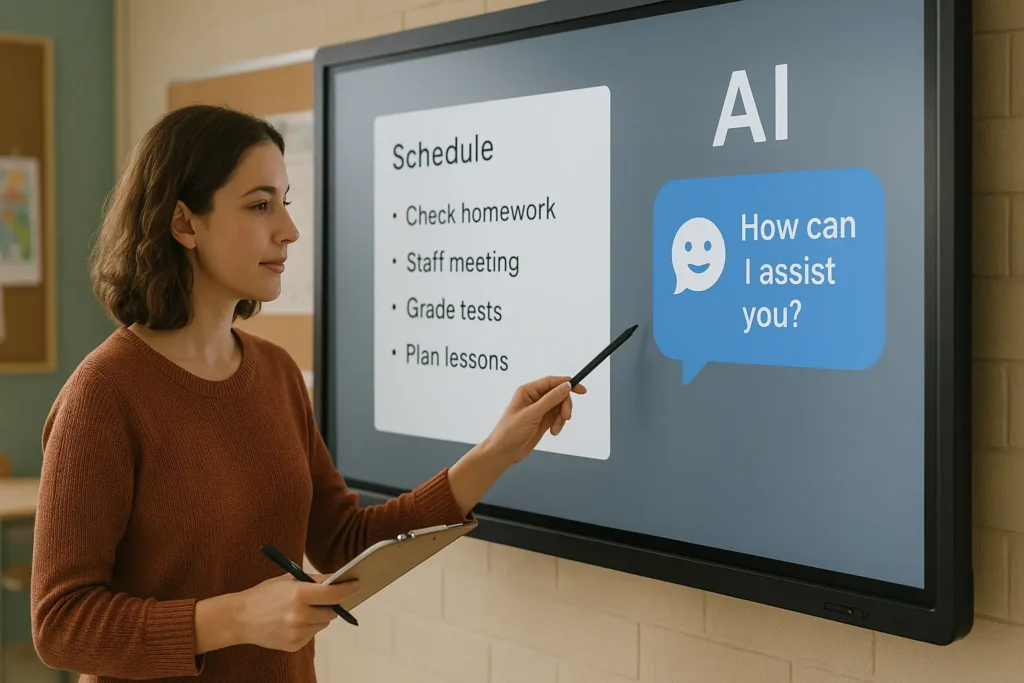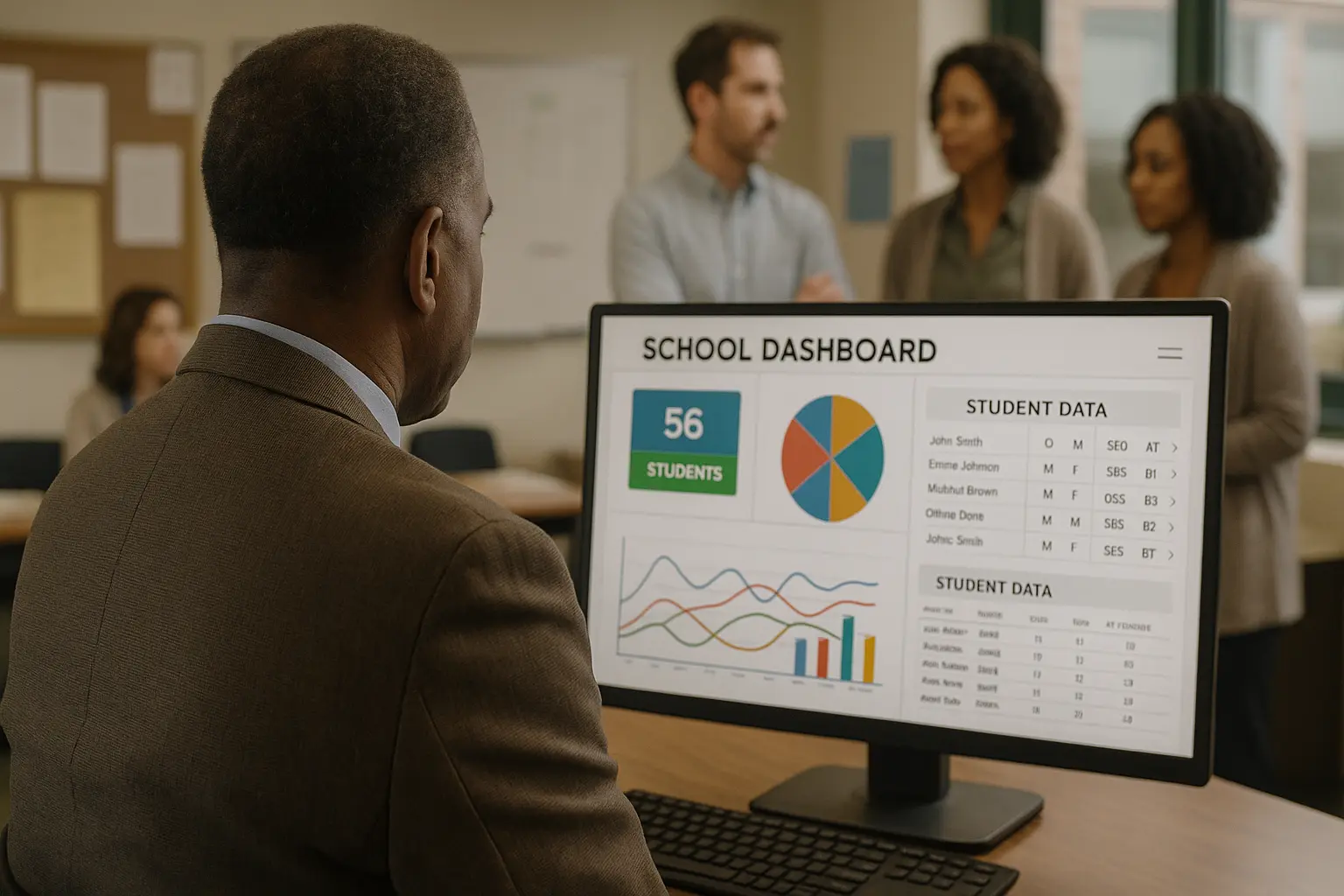Artificial Intelligence (AI) is no longer a distant future—it’s here, and it’s already transforming our schools. AI in Education for School Administrators is a topic that might seem intimidating at first, but don’t worry. In this guide, we’ll break it down in a simple, human way. Think of it like chatting with a trusted friend over coffee, not reading a technical manual.
What Is AI in Education for School Administrators?
At the beginning of this journey, it’s important to understand what we mean by AI in Education for School Administrators. Simply put, AI refers to machines that can perform tasks that usually require human intelligence—like understanding language, recognizing patterns, and even making decisions.
For school administrators, AI tools can help with managing school data, improving teaching quality, and making better decisions. You don’t need to be a tech expert to benefit. Just an open mind and a willingness to learn.
A Real-Life Example to Make It Clear
Imagine you’re a school principal, and you want to know how each student is doing. Instead of digging through piles of reports, an AI tool can quickly show you who needs help in math or reading. This way, you can support teachers and guide students more effectively.
And not only that—these insights can even help you tailor school resources and plan support strategies that are more equitable and inclusive, ensuring no student is left behind.
AI also allows for early identification of behavioral trends or attendance issues, helping staff intervene proactively rather than reactively. This kind of timely intervention can change the trajectory of a student’s educational journey.
How AI Can Help School Administration
AI isn’t here to replace humans—it’s here to help us. As a school leader, AI can become your new best friend when it comes to handling routine, time-consuming tasks.
1. Automating Routine Tasks
- Attendance tracking
- Report generation
- Scheduling classes and exams
These tasks often take hours. With AI, they can be done in minutes. That means you and your team can focus more on people than paperwork.
Additionally, by automating these tasks, schools reduce the chance of human error, creating more reliable systems that save time during audits, inspections, and yearly planning.
Even more, automation helps streamline collaboration between departments, as information becomes easier to access and share securely across systems.
2. Smart Decision Making
AI can look at a lot of data at once and show trends that humans might miss. For example:
- Which grade levels are falling behind?
- Which teachers need extra support?
- What kind of professional development would help your staff most?
This helps you make better decisions, based on real information.
It also allows you to react more quickly to emerging challenges—such as learning loss or mental health issues—by providing real-time insights instead of waiting for monthly or yearly reports.
Over time, these insights can help you develop predictive strategies and long-term action plans to prevent problems before they escalate.
3. Supporting Teachers and Staff
AI tools can assist teachers in planning lessons, grading assignments, and understanding student needs. As an administrator, you can use this information to provide better training and support.
For instance, if data shows that a group of students is struggling with writing skills, you can offer targeted writing workshops, or suggest tools that offer real-time feedback to teachers.
Moreover, AI can assist in monitoring professional growth by analyzing teacher feedback, classroom outcomes, and engagement levels, helping HR create personalized support paths.
AI Tools Administrators Can Use Today
Let’s look at some practical AI tools already helping school administrators:
1. Chatbots for Parent Communication
Chatbots, like those offered by Kommunicate, can answer parents’ questions instantly. No more overflowing inboxes.
These bots can be programmed to handle common queries about school hours, homework policies, and attendance—freeing up staff to handle more complex concerns.
You can also embed chatbots on school websites or parent portals to offer multilingual support, making communication more inclusive and accessible.
2. Predictive Analytics Platforms
Platforms like Knewton and Socrative help you track student performance and identify patterns—like who might be at risk of failing—before it’s too late.
These platforms can also inform curriculum planning by revealing which topics need more instructional time or where teachers might need additional resources.
As a result, instructional time becomes more effective and student outcomes improve across diverse learning groups.
3. AI for HR and Hiring
Tools such as Pymetrics use AI to analyze candidates’ skills and match them with the right job, saving time during recruitment.
You can also use AI tools to analyze feedback and performance trends among existing staff to build more personalized professional development plans.
Beyond recruitment, AI can track employee engagement and recommend strategies to improve retention and satisfaction.
Benefits of AI for School Administrators
Let’s take a look at how AI helps you be a more effective and supportive leader:
1. Saves Time
By automating everyday tasks, AI gives you more time to focus on what matters—your students and teachers.
This time savings can also improve work-life balance for school leaders, helping reduce burnout and increase job satisfaction.
You can then redirect time saved toward more meaningful interactions with students, staff, and parents.
2. Improves Accuracy
AI doesn’t get tired or distracted. It can process data with fewer errors and help you make more informed decisions.
Whether it’s budgeting or attendance tracking, using AI for accuracy ensures that your reports are more reliable when reporting to school boards or government agencies.
Accurate data also helps build trust with your school community, showing transparency and accountability.
3. Helps With Planning
Need to plan budgets or school growth strategies? AI tools can analyze trends and recommend the best actions to take.
These tools can also simulate different scenarios, allowing you to predict the outcomes of changes in staffing, enrollment, or curriculum with greater confidence.
This foresight enables you to make more strategic decisions and advocate more effectively for funding or resources.
4. Encourages Innovation
When you use AI, you set an example for your staff. It shows that your school embraces innovation and continuous improvement.
This mindset creates a school culture that values curiosity, experimentation, and lifelong learning, making your institution a leader in educational excellence.
Embracing technology can also inspire students to explore STEM careers, reinforcing the value of forward-thinking leadership.

Challenges and How to Overcome Them
No solution is perfect. Let’s talk about some common concerns and how to handle them.
1. Data Privacy and Security
Yes, using AI means collecting and storing a lot of data. But with tools that follow the LGPD (Brazil’s General Data Protection Law) or GDPR (in Europe), you can protect your students’ and staff’s information.
Consider also involving your school’s legal advisor or data protection officer when choosing tools to ensure full compliance.
Tip: Always choose AI providers that follow these legal standards.
Another good step is to offer data privacy workshops so all staff understand how to handle sensitive information properly.
2. Lack of Training
Not every teacher or staff member knows how to use AI. That’s okay. Start with basic training and offer continued support. Encourage a learning culture.
You can even assign digital mentors or tech-savvy staff to help others during the transition phase, building teamwork and shared responsibility.
Make sure to celebrate small wins and encourage feedback so the learning process feels safe and rewarding.
3. Budget Constraints
Some tools may seem expensive. However, many have free versions or government discounts for schools. Start small—maybe with an AI tool for scheduling or grading—and grow from there.
Additionally, think of AI as an investment. In the long run, the time saved can reduce costs in areas like hiring, overtime, and resource planning.
Schools can also explore grants or partnerships with edtech companies to fund pilot programs.
Practical Tips to Start Using AI in Your School
Here’s how you can begin, even if you feel unsure:
- Talk to Your Team: Discuss the idea of using AI with your staff. Ask what tasks take the most time and stress.
- Start Small: Pick one area to test—like attendance or student feedback.
- Choose User-Friendly Tools: Look for AI tools made for educators, not tech companies.
- Create a Plan: Set clear goals and check in often. What’s working? What needs adjusting?
- Celebrate Wins: Even small successes can build momentum and confidence.
Remember to gather feedback during each step and adjust based on what your team says. Involving your staff in decisions increases engagement and trust.
As momentum builds, consider creating an AI task force or committee to guide larger implementation plans and training sessions.
👉 Discover the truths behind common myths about AI in education and learn how it can enhance teaching and learning experiences.
The Human Touch Still Matters
AI is a tool—but you are the heart of your school. No machine can replace the compassion, creativity, and leadership that administrators bring. Think of AI as a trusted assistant, not a replacement.
As you introduce AI, emphasize empathy and connection. Technology works best when paired with human insight and care.
When used wisely, AI can free up your time and energy so you can focus on leading with heart and purpose.
Leading with compassion ensures AI enhances the human experience rather than replacing it—keeping schools warm, safe, and student-centered.
Key Points About AI in Education for School Administrators
- AI helps with administrative tasks like scheduling, grading, and communication.
- Tools like chatbots and analytics platforms simplify decision-making.
- AI can identify students at risk and suggest personalized interventions.
- It supports teachers with lesson planning and workload management.
- Challenges include data privacy, training, and budget—but they can be overcome.
- Start small, choose the right tools, and grow with confidence.
Conclusion
Artificial Intelligence is not something to fear. It’s a valuable ally that, when used right, can lighten your workload, enhance your leadership, and make your school more efficient and inclusive. As a school administrator, you have the power to shape the future of education—and AI is a tool to help you do that even better.
Let it support you, not overwhelm you. Begin small, grow steadily, and most importantly—always put people first.
What do you think? Have you tried any AI tools in your school yet? Leave a comment below and let’s share ideas!

